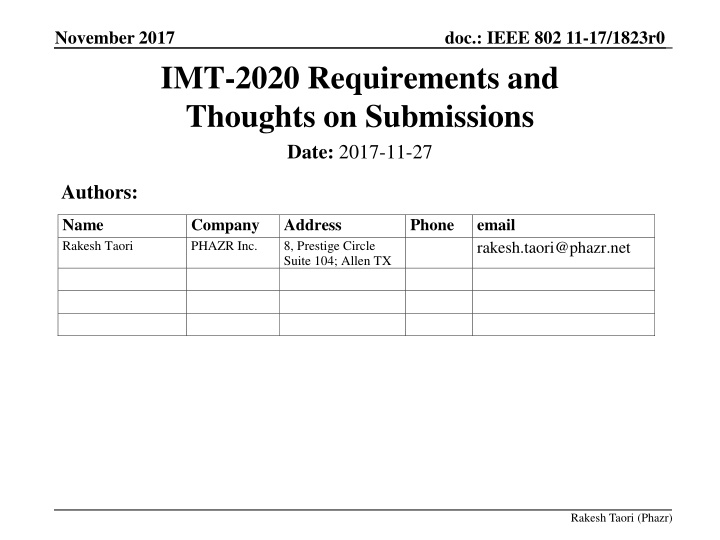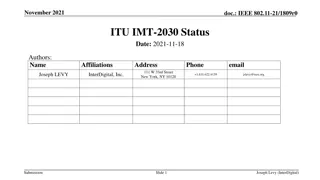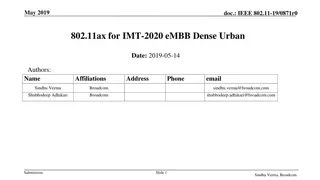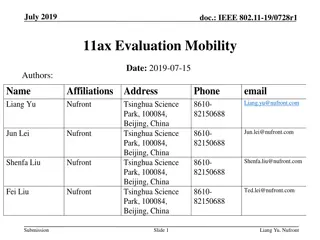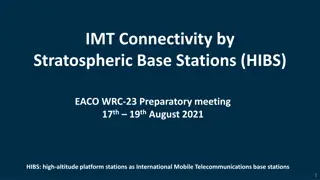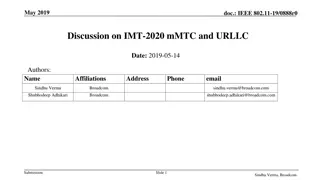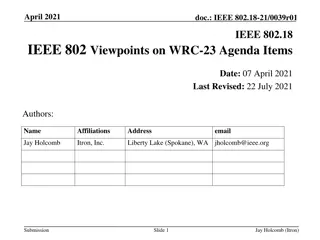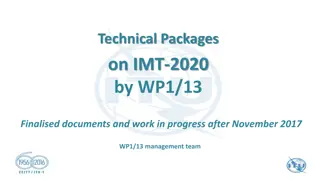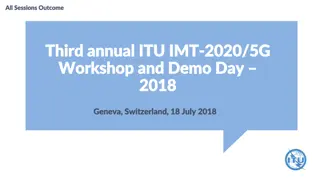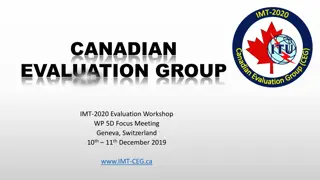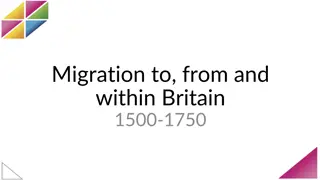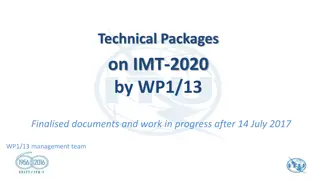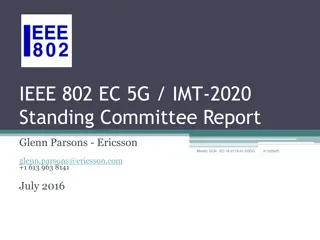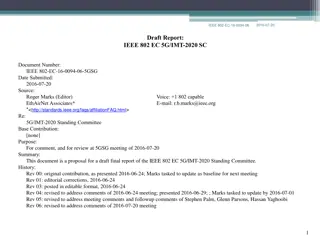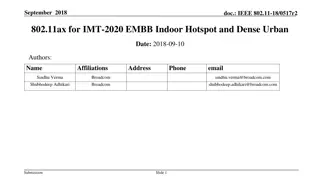IEEE 802.11-17/1823r0 IMT-2020 Requirements and Thoughts
This document discusses the qualification requirements, test environments, usage scenarios, and configurations for IEEE 802.11-17/1823r0 IMT-2020. It delves into the mobility requirements, clustering challenging requirements, and meeting high-level remarks efficiently.
Download Presentation

Please find below an Image/Link to download the presentation.
The content on the website is provided AS IS for your information and personal use only. It may not be sold, licensed, or shared on other websites without obtaining consent from the author.If you encounter any issues during the download, it is possible that the publisher has removed the file from their server.
You are allowed to download the files provided on this website for personal or commercial use, subject to the condition that they are used lawfully. All files are the property of their respective owners.
The content on the website is provided AS IS for your information and personal use only. It may not be sold, licensed, or shared on other websites without obtaining consent from the author.
E N D
Presentation Transcript
November 2017 doc.: IEEE 802 11-17/1823r0 IMT-2020 Requirements and Thoughts on Submissions Date: 2017-11-27 Authors: Name Rakesh Taori Company PHAZR Inc. Address 8, Prestige Circle Suite 104; Allen TX Phone email rakesh.taori@phazr.net Rakesh Taori (Phazr)
November 2017 doc.: IEEE 802 11-17/1823r0 Usage Scenarios, Test Environments and Configurations Test Environments Usage Scenarios Each test env. has multiple configurations (typically 3) Configurations Rakesh Taori (Phazr)
November 2017 doc.: IEEE 802 11-17/1823r0 Understanding the Qualification Requirements Test Environments Usage Scenarios To qualify for Step 7 (Our Goal): Meet min. requirements for 5 test environments comprising the 3 usage scenarios. Interim milestone at step 3: Rakesh Taori (Phazr)
November 2017 doc.: IEEE 802 11-17/1823r0 One Test Environment One configuration! For the cases when there are multiple evaluation configurations under the selected test environment, one of the evaluation configurations under that test environment can be used to test the candidate RITs/ SRITs. The technical performance requirement corresponding to that test environment is fulfilled if this requirement is met for one of the evaluation configurations under that specific test environment Rakesh Taori (Phazr)
November 2017 doc.: IEEE 802 11-17/1823r0 Clustering the seemingly challenging requirements Mobility Requirements (especially for Rural eMBB) 4 GHz configuration: 3 km/h (indoor), 120 km/h (in-car) and 500 km/h (high-speed) Low mobilty, large cell environment configuration : 3 km/h (indoor and pedestrian), 30 km/h (in-car) tested at 700 MHz Range Requirements (especially for Rural eMBB) 1732 m for sub-6 GHz (viz. 700 MHz and 4 GHz) 6000 m for 700 MHz Number of antenna elements per TRxP 64 Tx/Rx elements for frequencies 1 GHz (viz. 700 MHz) 256 Tx/Rx elements for frequencies above 1 GHz (viz. 4, 30, 70 GHz) Spectral efficiency Connection density Reliability Deep dive presentations can be invited on meeting each of these requirements! Rakesh Taori (Phazr)
November 2017 doc.: IEEE 802 11-17/1823r0 Some high-level remarks on meeting the requirements 11ac/ax waveform numerologies match the numerologies being considered for 5G applications Number of spatial streams in 802.11ac/ax same as other 5G waveforms MCS specifications in 802.11ac/ax is superior Most requirements that can be met by other 5G waveforms can be met by 802.11 as well Some requirements such as mobility will require a deeper analysis. Range can be met with higher EIRPs that are allowed in the bands under discussion When used outside the unlicensed bands, the 24/30 dBm EIRP restrictions do not apply! Number of Tx/Rx antenna elements are not limited by the standard Implementation dependent Rakesh Taori (Phazr)
November 2017 doc.: IEEE 802 11-17/1823r0 Some thoughts on Contributions to IMT-2020 According to IMT 2020/2(Rev.1), the (S)RIT candidate submissions begin in Oct 2017 and the final submissions are due by June 2019. Intermediate steps are outlined as well (e.g. beginning of independent evaluations in Jan 2018) Opinions have been expressed that we are not required to share anything until June 2019. It may be beneficial to prepare a submission summarizing: IEEE 802 s intent to submit a 5G (S)RIT proposal An overview of the how the proposal works Configurations, for each of the 5 test environments, for which the proposal will be tested Some high-level Analysis on how the proposal will meet the IMT-2020 requirements Discussion on Immediate actions Prepare a contribution along the lines discussed above for discussion in the Jan meeting (what gets submitted to the ITU can be debated F2F) Continue to seek volunteers for the templates Rakesh Taori (Phazr)
November 2017 doc.: IEEE 802 11-17/1823r0 APPENDIX Rakesh Taori (Phazr)
November 2017 doc.: IEEE 802 11-17/1823r0 802.11 Waveforms vs. 5G Waveforms Rakesh Taori (Phazr)
